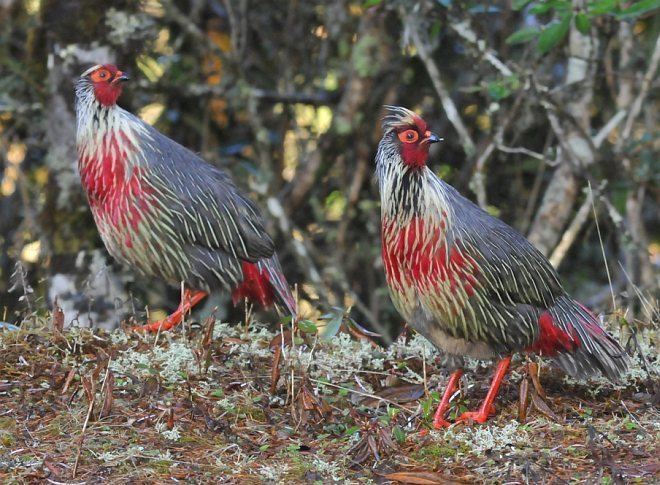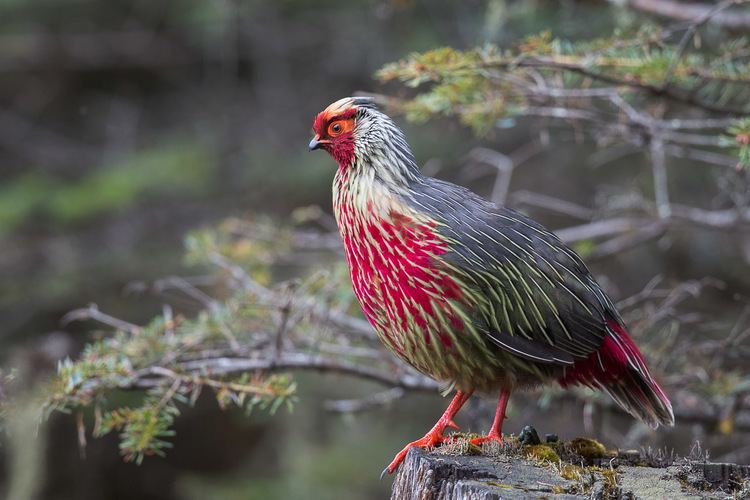The species of the blood pheasant is classified under Kingdom Animalia, Subfamily Phasianinae, and Scientific name Ithaginis cruentus. It belongs to the family Phasianidae and the Order Galliformes. The genus Ithaginis was named by Wagler in 1832. The blood pheasant has a length of approximately 43 cm when it has reached adulthood. It is a member of the Chordata phylum.

The Blood Pheasant, scientifically known as Ithaginis cruentus, is a type of pheasant found in the Himalayas. It is the only species in its genus, Ithaginis, and is relatively small with a short tail. The Blood Pheasant can be found across India, Nepal, Bhutan, and China, and is fairly common in the eastern Himalayas. However, its population seems to be slowly decreasing, leading to its classification as Least Concern by the IUCN in 2009. The Blood Pheasant has also been designated as the state bird of Sikkim in India. Other similar birds include the Himalayan Monal, Satyr Tragopan, Koklass Pheasant, Tragopan, and Monal.

The following is a suggestion to avoid plagiarism when paraphrasing content:
When attempting to paraphrase existing content, it is important to first understand the main ideas and arguments being presented. Once you have identified these key points, try to rephrase them in your own words while maintaining the same meaning. You can also add your own thoughts and insights to make the content more unique and original. It’s important to properly cite any sources used in your writing to avoid plagiarism. Remember that even if you are paraphrasing someone else’s work, it still requires proper attribution.

Blood pheasants are small-sized birds, with a length of approximately 17 inches (43 cm). They have a short, strongly curved, black bill which is feathered between the bill and the eye. Additionally, they have a small crest that is made up of various colored feathers. The plumage above the body is dark ash in color with white shafts. The coverts of the wings have various shades of green with broad strokes of white throughout each feather. The feathers on the chin are deep crimson in color. On the breast, belly and sides, the feathers are lance-shaped and of varying lengths. The tips of these feathers are green with crimson margins. Collectively, these feathers resemble dashes of blood scattered on the breast and belly. The tail consists of twelve sub-equal feathers with white shafts. The ends of the feathers are whitish, while the coverts are a rich crimson red.

Male and female birds of this species have similar physical characteristics, such as red feet and a bare skin ring around their eyes. However, females tend to be more uniformly colored, with a dull brown overall appearance and some gray on their nape. While some of the described subspecies are noticeably distinct, others show varying degrees of difference and are subject to debate regarding their validity. Some authorities recognize between 11 to 15 subspecies, which mainly differ in the male’s plumage, particularly the amount of red or black on their throat, forehead, neck, chest, and tail, as well as the presence or absence of rufous in their wings. Currently, there are twelve recognized subspecies.

The dispersion and natural dwelling place of living beings

Blood pheasants are a species of bird that can be found living in the mountains of various Asian countries including Nepal, Sikkim, Myanmar, Tibet and China. They tend to reside in areas with mixed forests and scrublands near the snowline, although their exact location changes depending on the season. During the summer months, blood pheasants can be found at higher elevations, while they move to lower elevations during the fall and winter as snow levels increase.
